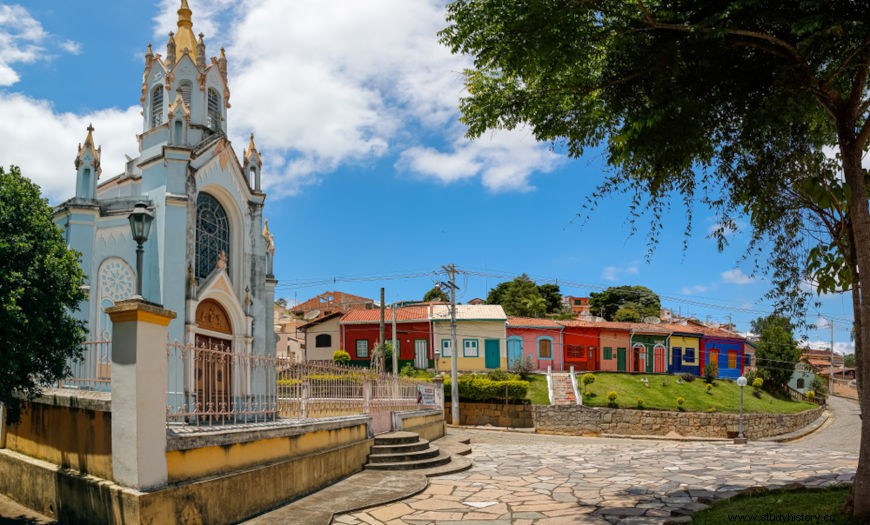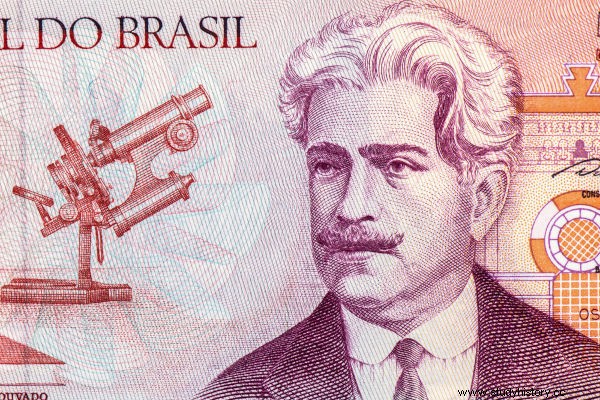Oswaldo Cruz was a sanitarian who bequeathed a great contribution to public health in Brazil. He was responsible for campaigns that eradicated yellow fever in Rio de Janeiro and promoted the deratization of the city as a way to fight the bubonic plague. He was also the creator of the vaccination campaign that resulted in the Vaccine Revolt.
Go to also :Plague of Athens - mysterious disease that struck Athens in the 5th century BC
Birth and Youth
Oswaldo Gonçalves Cruz was born in São Luiz do Paraitinga, in the state of São Paulo, on August 5, 1872. His family was formed by his father, Bento Gonçalves , a doctor; by Amália Tabord Bullions Cross , his mother; and for her five sisters, Eugenia, Amália, Alice, Noemi and Hortênsia.

In 1877, Oswaldo Cruz's family decided to move to Rio de Janeiro (his parents were from there), where his father set up a medical clinic. Oswaldo Cruz's formal education took place in schools in the capital, and as a teenager he decided to follow in his father's footsteps, entering the Faculty of Medicine in 1886.
Medical Career
Oswaldo Cruz graduated in medicine in 1892, at the same time that a tragedy affected his family:his father died of nephritis. This forced him to work at the clinic from the family to get the support da mother and sisters .
Also, Oswaldo Cruz was engaged to Emília da Fonseca , whom he married on January 5, 1893. Working at the clinic was a pragmatic decision, since his great interest were studies in the areas of microbiology and infectious diseases . However, the area that would give him the greatest financial return, at that moment, was the clinic.
Your father-in-law , a merchant named Manuel da Fonseca, was of great help for the development of his son-in-law's career as a health worker, as he financed a modern laboratory for him and a trip to Paris, so that he could expand his knowledge.
In France , Oswaldo lived in his in-laws' house and studied at Instituto Pasteur and at the Institute of Toxicology , expanding their knowledge in areas such as microbiology, bacteriology, serum therapy, etc. When he returned to Brazil in 1899, he decided to set up a urology clinic and a laboratory in Rio de Janeiro .
Public Health
As we know, Oswaldo Cruz was one of the great names in public health in Brazil, and throughout his life he made very important contributions to the country. His first involvement with public health took place in 1894, when he was invited to investigate an outbreak that took place in the Paraíba Valley .
Based on samples analyzed in his private laboratory, Oswaldo Cruz and other scientists concluded that what was affecting the region was cholera , one of the diseases that killed the most in the 19th century. The conclusion that there was cholera in the Vale do Paraíba led authorities in Rio de Janeiro, São Paulo and Minas Gerais to expand sanitation efforts to prevent further outbreaks.
In 1899, Oswaldo Cruz was invited to analyze an outbreak that happened in the city of Santos . After a few days of work, it was already possible to verify the presence of plague bubonic in the city. The outbreak of this disease in Santos forced the authorities to invest in serum therapy, the only treatment for her at the time.
During this period, it was necessary to import serum from France, and, to avoid this, two serotherapy institutes were created:the Instituto Butantã , in São Paulo, and the Instituto Serotherapy Federal , in Rio de Janeiro. Oswaldo Cruz was part of the team responsible for the first doses of antiplague serum produced in Brazil, in 1900.
Login also :Five diseases that marked the history of humanity
Work in the General Directorate of Public Health

In 1903, the city of Rio de January was undergoing a major renovation , conceived by the president, Rodrigues Alves, and executed by the city's mayor, Pereira Passos. First there was the architectural renovation of the city, and the other side of it was the toilet.
At the beginning of the 20th century, three diseases affected thousands of people in Rio de Janeiro every year and caused serious epidemics in the city. For this reason, Oswaldo Cruz was invited to assume the General Directorate of Public Health, a body that corresponded to the current Ministry of Health. The sanitarian's main objective was to end the smallpox epidemics , fever yellow and plague bubonic .
In the case of yellow fever and bubonic plague, the fight took place through actions against their vectors :the mosquito and the mouse. The action of health agencies in Rio de Janeiro was, to say the least, truculent. The health brigades went from house to house, especially in the poorest regions, and invaded properties looking for places that could serve as breeding grounds for mosquitoes and rats.
Furthermore, to prevent the disease from spreading throughout the city, the DGSP had all patients gathered in specific locations (with the exception of wealthy citizens). Landlords were forced to keep their properties clean and carry out renovations, and fines were given to those who did not meet the requirements.
In the case of rats, the DGSP also encouraged the population to hunt them down and deliver them to health agents in exchange for cash compensation. The final outcome of this action, especially in the case of yellow fever, was a great success, as the outbreak of this disease subsided considerably. In the case of the bubonic plague, the action of the DGSP caused thousands of rats to be killed .
Login also :Do you know what the Spanish flu was?
Vaccine Revolt
Finally, there was smallpox , an infectious disease that had a high mortality rate and that affected thousands of people at the beginning of the 20th century. To combat it, the solution was to carry out a campaign from vaccination in the population. It was announced in 1904 that smallpox vaccination would be mandatory .
The population of Rio de Janeiro was dissatisfied with the mandatory vaccination due to a series of factors, which included the lack of information, for example. Thousands of people were vaccinated, but the result of the vaccination was a massive uprising in Rio de Janeiro. The population took to the streets on November 10, 1904, promoting a break through the capital.
This popular riot took the name of Revolta da Vacina, and the situation in Rio de Janeiro was normalized a few days later. The material damage in the capital was great, and dozens of people died during the acts in the city. The mandatory vaccine was withdrawn after the popular uprising. To learn more about this conflict, read:Vaccine Revolt.
Death
The last years of Oswaldo Cruz's life were affected by nephritis , the same kidney disease that had killed his father. Little by little, this condition manifested itself and limited the time the doctor could dedicate to work. In 1909, Oswaldo Cruz left the General Directorate of Public Health and, in 1915, the Instituto Oswaldo Cruz (formerly Instituto Soroterápico Federal).
Moved to Petrópolis looking for a healthier lifestyle for his health condition. He went on to become mayor of the city , but left office due to the aggravation of his illness, dying on February 11, 1917 , due to renal failure.
